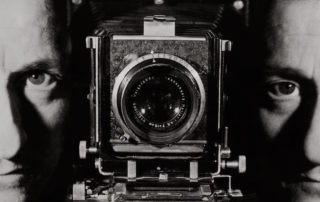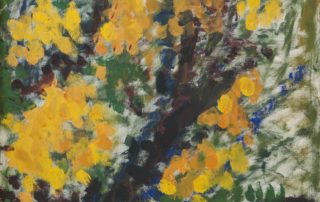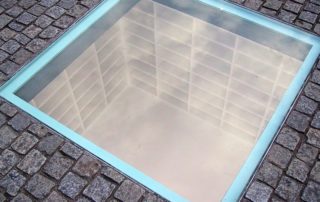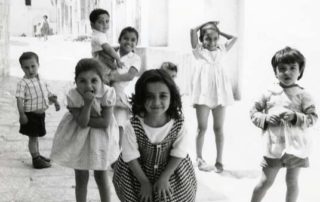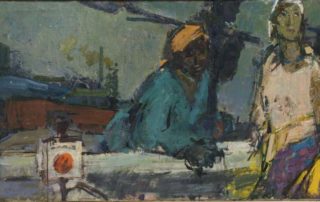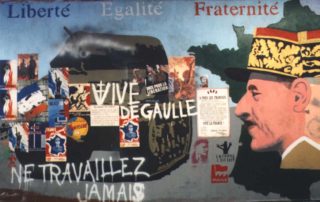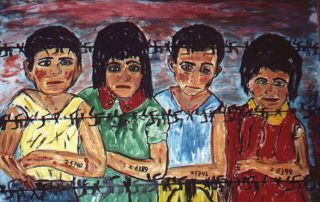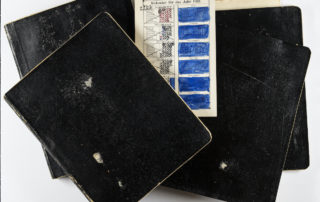Rachel Stern2023-06-11T08:09:34-04:00May 31st, 2023|Newsletter|
In the 1940s, Erwin Blumenfeld established himself in New York as one of the leading photographers. Join us online to hear Paris-based granddaughter Nadia Blumenfeld Charbit give her personal insights into his life and work: WEDNESDAY, JUNE 7 12:00 pm ET / 18:00 Uhr CET ”Erwin Blumenfeld (1897-1968), from Berlin to New York. A Life in Photography” REGISTER FOR THIS ZOOM EVENT HERE Erwin Blumenfeld, The red cross, for Vogue US, 1945. © Erwin Blumenfeld Estate “No medium of expression is art unless it becomes a vehicle for successfully transmitting an emotion from the one using to the one viewing it – and if it does this what difference is there what raw materials are used?” [...]
Rachel Stern2023-06-11T07:42:53-04:00April 23rd, 2023|Newsletter|
The big anniversaries keep coming up - this week is the 75th anniversary of the establishment of the modern state of Israel in 1948. In honor of Yom Ha’azmaut, join us for Georgetown University professor Ori Z Soltes’ talk about what defines Israeli art and when it began to take shape. WEDNESDAY, APRIL 26 12:00 pm ET / 18:00 Uhr CET ONLINE EVENT ”Benno Elkan (1877-1960) and the Definition of Israeli Art” REGISTER FOR THIS ZOOM EVENT HERE Benno Elkan, Menorah, 1956. Bronze, 4.30 meters high, 3.5 meters wide. Gan Havradim (Rose Garden) opposite the Knesset, Jerusalem. Presented to the Knesset as a gift from the Parliament of the United Kingdom Parliament on April [...]
Rachel Stern2023-04-26T13:54:56-04:00April 19th, 2023|Events, Lectures, Past Events|
In honor of Yom Ha'azmaut, Israel's Independence Day, and this year's 75th anniversary of the establishment of the modern state of Israel in 1948, this talk by Georgetown University professor Ori Z Soltes addresses the question of what defines Israeli art and when it began to take shape. Is it made only by Israelis---then how did Elkan's Menorah become the consummate symbol of Israel when he never lived in the state? Did "Israeli" art begin with or before the birth of the state? How does this relate to the opening of the Bezalel School of Art in 1906--and closing by 1929, only to re-open years later? How does it relate to the question of defining Jewish art? Benno Elkan's stunning work, [...]
Rachel Stern2023-04-03T09:59:19-04:00March 30th, 2023|Newsletter|
Spring is here! Let’s celebrate with Fritz Ascher’s blossoming Golden Chain. Just this past week, March 26, marked the 53rd anniversary of his death. Born in 1893 to Jewish parents in Berlin, Fritz Ascher (1893-1970) survived persecution by the German Nazi regime in hiding. Fritz Ascher, Golden Chain, ca 1959. Oil on canvas, 25.6 x 27.6 in. (65 x 70 cm). ©Bianca Stock Watch New York scholars Karen Wilkin and Elizabeth Berkowitz, PhD, discuss his post-1945 landscapes: WATCH THE RECORDING Dr. Eva Sabrina Atlan’s January 11 lecture in our virtual lecture series “Flight or Fight. stories of artists under repression” has found much interest. Today, we are excited to offer an English-language virtual [...]
Rachel Stern2023-04-17T19:19:05-04:00March 6th, 2023|Events, Lectures, Past Events|
In honor of Yom HaShoah, this talk by Georgetown University professor Ori Z Soltes focuses on three Israeli and three American familiar and unfamiliar artists working in very diverse styles and not typically thought of as focusing on the Holocaust. Each of them, however, has offered powerful reflections on the defining catastrophe of the twentieth century. Barnett Newman, the foremost verbal spokesman for the chromatic side of the abstract expressionist movement redefining American painting in the early 1950s, offers an unexpectedly intense reflection on the question of theodicy. Mordecai Ardon, in the process of assuming leadership of the Bezalel school in Jerusalem at around the same time, balances between abstraction and figuration in depicting the Nazi-engendered chaos. Yigal Tumarkin’s [...]
Rachel Stern2023-02-23T08:11:27-05:00February 23rd, 2023|Newsletter|
Have we got exciting events for you! Hear about the influential British photographer Dorothy Bohm, now aged 98, from her daughter: Wednesday, March 1 12:00 pm EST / 17:00 Uhr GMT DOROTHY BOHM (B. 1924): A WORLD OBSERVED Lecture by Monica Bohm-Duchen ZOOM EVENT REGISTRATION Dorothy Bohm, Haifa, Israel, 1959. © Dorothy Bohm Archive London-based art historian Monica Bohm-Duchen will give her personal insights into the life and work of her mother, photographer Dorothy Bohm, who as a girl of fourteen found sanctuary from Nazi Europe in the UK, and in due course established herself as one of the leading figures in post-war British photography. Dorothy Bohm was born Dorothea Israelit [...]
Rachel Stern2023-03-15T14:04:18-04:00January 24th, 2023|Events, Lectures, Past Events|
The program features a talk by Lembersky’s granddaughter, Yelena Lembersky, co-author of the recent and highly acclaimed memoir, Like a Drop of Ink in a Downpour: Memories of Soviet Russia. Yelena will be introduced by Georgetown University professor, Ori Z Soltes, who has known her for many years and has written extensively on the work of Felix Lembersky. “We are merely honest people and see what is good and bad, and we cannot be confused.” – Felix Lembersky, Leningrad, the Soviet Union, 1960 Image above: Felix Lembersky, At the Train Station, ca 1960-64. © Felix Lembersky estate Felix Lembersky (1913-1970) was a Soviet Jewish painter, teacher, theater sets designer, and an organizer of artistic groups in Leningrad and [...]
Rachel Stern2023-02-15T19:21:41-05:00January 8th, 2023|Events, Lectures, Past Events|
Inspired by a visit to his birth country in the 1990s, American artist Philip Orenstein (b. 1938) created seven murals about the French complicity in the persecution of Jews in France during World War II. At that time, the French government had not admitted it had taken part in the persecution. The murals have been shown in various galleries and museums in the United States. In 1999, William Zimmer wrote in the New York Times, “Mr. Orenstein’s method involves combining poignancy with the determination that the viewers not miss the story. To this end, Mr. Orenstein skillfully, and wittily, employs the look of today’s splashy graffiti.” The works have not yet been shown in France. Born in Paris, France, in 1938, [...]
Rachel Stern2023-02-06T07:18:23-05:00January 8th, 2023|Events, Lectures, Past Events|
The Kunstmuseum Basel’s department of classic modernism houses one of the most prestigious collections of its kind. It was in fact assembled at a comparatively late date. In the summer of 1939 — shortly before the outbreak of World War II — Georg Schmidt (1896–1966), the museum’s director at the time, managed to acquire twenty-one avant-garde masterpieces all at once. The works were among those denounced in 1937 by Nazi cultural policy as “degenerate” and forcibly removed from German museums. The Third Reich’s Ministry of Propaganda correctly assumed that a portion of such works would find buyers abroad and bring in foreign currency. In this way certain artworks deemed “internationally exploitable” reached the art market via various channels. [...]
Rachel Stern2023-02-01T06:15:59-05:00December 1st, 2022|Events, Lectures, Past Events|
In honor of UN Holocaust Remembrance Day, Hilary Helstein, director of the award-winning documentary "As Seen Through These Eyes" spoke with Rachel Stern, director and CEO of the Fritz Ascher Society New York, about the making of her documentary. As poet Maya Angelou narrates this powerful documentary, she reveals the story of a brave group of people who fought Hitler with the only weapons they had: charcoal, pencil stubs, shreds of paper and memories etched in their minds. These artists took their fate into their own hands to make a compelling statement about the human spirit, enduring against unimaginable odds. Featuring interviews with Simon Wiesenthal as he talks about his art, never before appearing in a film, [...]
Rachel Stern2022-12-07T18:53:36-05:00May 25th, 2022|Events, Lectures, Past Events|
Image above: Samuel Bak, Warsaw Excavation, 2007. Oil on canvas, 16 x 20 in. Image Courtesy Pucker Gallery © Samuel Bak Samuel Bak was 6 years old when the Nazis began ending his childhood, as the war that they engendered would soon extend to his native Vilnius. The number “6” became an important element in his art, since it is also the number of the Commandment with which God enjoins us not to commit murder, for which the Holocaust represented such a profound abrogation. His father smuggled him out of the ghetto in the sack that he was still permitted to use to gather firewood—and was subsequently murdered by the regime. By then Bak himself had already [...]
Rachel Stern2022-04-28T09:33:15-04:00April 26th, 2022|Newsletter|
Dear Friends, Thursday is Yom HaShoah - Holocaust Memorial Day. In January, we invited you to actively commemorate victims of National Socialism by contributing to the Arolsen Archive’s digital memorial #EVERYNAMECOUNTS. I know that some of you found the project so meaningful that you are still donating your time to it. Right now, you can choose to enter data of documents from Buchenwald, Flossenbürg or Dachau: PARTICIPATE HERE This Thursday, I invite all to donate time to help build this important digital memorial. On our website you find further information about the project and our partnership with the Arolsen Archive: https://fritzaschersociety.org/digifas/everynamecounts/ And please share your experience with us! In May, we turn to the experience of [...]


